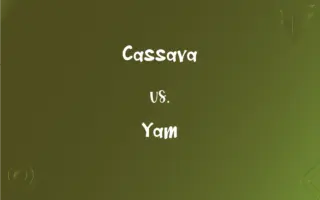Rhombus vs. Kite: What's the Difference?
Edited by Harlon Moss || By Janet White || Published on December 4, 2023
A rhombus is a parallelogram with equal sides, while a kite has two pairs of adjacent equal-length sides.

Key Differences
A rhombus is a quadrilateral with all sides of equal length and opposite sides parallel, often described as a slanted square. A kite, in contrast, is defined by having two distinct pairs of adjacent sides that are equal in length, but not necessarily all sides are equal, giving it a distinct, asymmetrical shape.
In terms of angles, a rhombus has opposite angles that are equal, and its diagonals bisect each other at right angles. A kite, however, typically does not have equal opposite angles, and while one diagonal bisects the other, they do not necessarily do so at right angles.
Symmetry plays a key role in differentiating these two shapes. A rhombus has both line and rotational symmetry, making it highly symmetrical. A kite, on the other hand, generally only has one line of symmetry and lacks rotational symmetry.
When considering the diagonals, a rhombus's diagonals are always perpendicular and bisect each other into equal segments. In a kite, one diagonal bisects the other, but they are not necessarily perpendicular, and the segments they create are not equal in length.
From a geometric perspective, every rhombus can be considered a kite, but not every kite is a rhombus. This is due to the specific length requirements of a rhombus's sides, which are more restrictive than those of a kite.
ADVERTISEMENT
Comparison Chart
Side Lengths
All sides are equal
Two pairs of adjacent equal sides
Angles
Opposite angles are equal
No equal opposite angles
Symmetry
Line and rotational symmetry
One line of symmetry
Diagonals
Perpendicular and bisect equally
Bisect but not always perpendicular
Geometric Inclusion
Is a parallelogram
Not a parallelogram
ADVERTISEMENT
Rhombus and Kite Definitions
Rhombus
A rhombus has diagonals that bisect each other at right angles.
In the rhombus, the diagonals intersected at a perfect 90 degrees.
Kite
It is a shape where one diagonal bisects the other.
In their kite, one diagonal neatly divided the other into two segments.
Rhombus
A rhombus is a four-sided shape with all sides of equal length.
The rhombus in the diagram had sides each measuring 5 cm.
Kite
A kite is a quadrilateral with two distinct pairs of adjacent equal-length sides.
The kite they created in geometry class had two pairs of equal sides.
Rhombus
It is a type of parallelogram with equal and parallel opposite sides.
She drew a rhombus, noting how its opposite sides were parallel.
Kite
It often has one line of symmetry through its longer axis.
The kite showed a clear line of symmetry when folded along its longer axis.
Rhombus
A rhombus is also known as an equilateral quadrilateral.
The child described the rhombus as an equilateral quadrilateral.
Kite
A kite can resemble the flying object of the same name in shape.
Their paper kite, much like its geometric namesake, soared high in the sky.
Rhombus
It is characterized by having four equal interior angles.
The rhombus he sketched had equal angles of 90 degrees each.
Kite
A kite has one pair of opposite angles that are equal.
The angles opposite the longer sides of the kite were equal.
Rhombus
An equilateral parallelogram, especially one having oblique angles. Also called rhomb.
Kite
A light framework covered with cloth, plastic, or paper, designed to be flown in the wind at the end of a long string or multiple lines, especially for recreation.
Rhombus
(geometry) A parallelogram having all sides of equal length.
Rhombus
The rhombus diamond, as one of the suits seen in a deck of playing cards (♦ or ♦).
Rhombus
In early Greek religion, an instrument whirled on the end of a string similar to a bullroarer.
Rhombus
Any of several flatfishes, including the brill and turbot, once considered part of the genus Rhombus, now in Scophthalmus.
Rhombus
Snails, now in genus Conus or family Conidae.
Rhombus
Same as Rhomb, 1.
Rhombus
A parallelogram with four equal sides; an oblique-angled equilateral parallelogram
FAQs
Is a square a type of rhombus?
Yes, a square is a special type of rhombus where all angles are also equal (90 degrees).
Are all sides of a rhombus parallel?
Yes, opposite sides of a rhombus are parallel to each other.
Are the diagonals of a rhombus equal?
No, the diagonals of a rhombus are not equal but they bisect each other at right angles.
What is a rhombus?
A rhombus is a type of quadrilateral with all four sides of equal length.
Can a rhombus be a rectangle?
No, a rhombus cannot be a rectangle unless it's a square.
Is a rhombus always symmetrical?
Yes, a rhombus is always symmetrical along its diagonals.
What are the properties of a rhombus?
Equal sides, opposite sides parallel, diagonals bisect at right angles, and rotational symmetry.
How do you calculate the area of a rhombus?
The area can be calculated as the product of its diagonals divided by 2.
Does a rhombus have right angles?
Generally, no. However, a square, which is a special case of a rhombus, does have right angles.
Is a kite a type of rhombus?
No, a kite and a rhombus are different due to their side length properties.
What is a kite in geometry?
A kite is a quadrilateral with two pairs of adjacent sides that are equal.
Are all sides of a kite equal?
No, only two pairs of adjacent sides are equal.
Do the diagonals of a kite intersect at right angles?
Yes, one pair of diagonals in a kite intersect at right angles.
Are the angles of a kite always equal?
No, only the angles between equal sides are equal.
Can a kite be a square?
No, a kite cannot be a square as it doesn't have all sides and angles equal.
Can a kite be a parallelogram?
No, a kite cannot be a parallelogram because its opposite sides are not parallel.
What symmetry does a kite have?
A kite has one line of symmetry along its axis of symmetry.
Is a kite always convex?
Yes, a kite is always a convex quadrilateral.
Can a rhombus be a kite?
No, a rhombus cannot be a kite because a kite requires exactly two pairs of adjacent equal sides.
How do you find the area of a kite?
The area is half the product of its diagonals.
About Author
Written by
Janet WhiteJanet White has been an esteemed writer and blogger for Difference Wiki. Holding a Master's degree in Science and Medical Journalism from the prestigious Boston University, she has consistently demonstrated her expertise and passion for her field. When she's not immersed in her work, Janet relishes her time exercising, delving into a good book, and cherishing moments with friends and family.
Edited by
Harlon MossHarlon is a seasoned quality moderator and accomplished content writer for Difference Wiki. An alumnus of the prestigious University of California, he earned his degree in Computer Science. Leveraging his academic background, Harlon brings a meticulous and informed perspective to his work, ensuring content accuracy and excellence.








































































